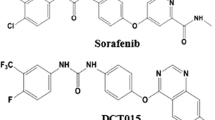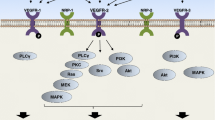Abstract
Background
CD9 is a member of the tetraspanins, and has been shown to be involved in a variety of cellular activities such as motility, cell signaling, proliferation, adhesion, and metastasis. However, very little is known about the involvement of CD9 in the process of development of primary tumors. In the present study, we investigated whether anti-CD9 monoclonal antibody (ALB6) has antitumor effects in human gastric cancer cell xenografts.
Methods
Human gastric cancer cell lines (MKN-28) (5 × 106 cells/animal) were inoculated subcutaneously into the dorsal region of SCID mice (five mice in each group). After a tumor was visualized, animals were assigned to either the ALB6 treatment group or the control IgG treatment group (100 μg/body/time, intravenous, three times per week. Day 1, 4, and 7 of first week). Then tumor volumes were monitored every day. Proliferation of tumor was analyzed by 5-bromo-2′-deoxyuridine (BrdU) immunostaining, apoptosis was determined by terminal deoxynucleotidyl transferase-mediated dUTP-biotin nick-end labeling (TUNEL) methods, and angiogenesis was assessed by counting the number of CD34-positive endothelial cells.
Results
Tumor volume was significantly suppressed (1,682 ± 683 mm3 versus 4,507 ± 1,012 mm3; P = 0.049), the BrdU labeling indexes were significantly decreased (10.9 ± 1.1% versus 17.2 ± 1.4%; P = 0.009), the apoptotic indexes were significantly increased (1.98 ± 0.48% versus 0.72 ± 0.09%; P = 0.034), and tumor microvessel densities were significantly suppressed (671,922 ± 34,505 pixels/mm2 versus 1,135,043 ± 36,086 pixels/mm2; P = 0.037) in the ALB6 treatment group compared with the control IgG treatment group.
Conclusions
These results suggest that administration of anti-CD9 antibody to mice bearing human gastric cancer cells successfully inhibits tumor progression via antiproliferative, proapoptotic, and antiangiogenetic effects.




Similar content being viewed by others
Abbreviations
- BrdU:
-
5-Bromo-2′-deoxyuridine
- JNK/SAPK:
-
c-Jun NH2-terminal kinase/stress-activated protein kinase
- MAPK:
-
Mitogen-activated-protein kinase
- TUNEL:
-
Terminal deoxynucleotidyl transferase-mediated dUTP-biotin nick-end labeling
- ABC:
-
Avidin–biotin peroxidase complex
- DAB:
-
3,3′-Diaminobenzidine tetrahydrochloride
- FCS:
-
Fetal calf serum
- PBS:
-
Phosphate-buffered saline
- EGFR:
-
Epidermal growth factor receptor
- SEM:
-
Standard error of the mean
- cDNA:
-
complementary Deoxyribonucleic acid
References
WHO. World Health Organization fact sheet no. 297: cancer WHO fact sheet, vol 2007. WHO, 2006.
Jemal A, Siegel R, Ward E, Murray T, Xu J, Smigal C, et al. Cancer statistics. CA Cancer J Clin. 2006;56:106–30.
Gallo A, Cha C. Updates on esophageal and gastric cancers. World J Gastroenterol. 2006;12:3237–42.
Maecker HT, Todd SC, Levy S. The tetraspanin superfamily: molecular facilitators. FASEB J. 1997;1:428–42.
Berditchevski F. Complexes of tetraspanins with integrins: more than meets the eye. J Cell Sci. 2001;14:4143–51.
Hemler ME. Tetraspanin proteins mediate cellular penetration, invasion, and fusion events and define a novel type of membrane microdomain. Ann Rev Cell Dev Biol. 2003;19:397–422.
Boucheix C, Rubinstein E. Tetraspanins. Cell Mol Life Sci. 2001;58:1189–205.
Hemler ME. Tetraspanin functions and associated microdomains. Nat Rev Mol Cell Biol. 2005;10:801–11.
Miyake M, Koyama M, Seno M, Ikeyama S. Identification of the motility-related protein (MRP-1), recognized by monoclonal antibody M31–15, which inhibits cell motility. J Exp Med. 1991;174:1347–54.
Higashiyama M, Taki T, Ieki Y, Adachi M, Huang CL, Koh T, et al. Reduced motility related protein-1 (MRP-1/CD9) gene expression as a factor of poor prognosis in non-small cell lung cancer. Cancer Res. 1995;55:6040–4.
Huang CI, Kohno N, Ogawa E, Adachi M, Taki T, Miyake M. Correlation of reduction in MRP-1/CD9 and KAI1/CD82 expression with recurrences in breast cancer patients. Am J Pathol. 1998;153:973–83.
Mori M, Mimori K, Shiraishi T, Haraguchi M, Ueo H, Barnard GF, et al. Motility related protein 1 (MRP1/CD9) expression in colon cancer. Clin Cancer Res. 1998;4:1507–10.
Sho M, Adachi M, Taki T, Hashida H, Konishi T, Huang CL, et al. Transmembrane 4 superfamily as a prognostic factor in pancreatic cancer. Int J Cancer. 1998;79:509–16.
Houle CD, Ding XY, Foley JF, Afshari CA, Barrett JC, Davis BJ. Loss of expression and altered localization of KAI1 and CD9 protein are associated with epithelial ovarian cancer progression. Gynecol Oncol. 2002;86:69–78.
Cajot JF, Sordat I, Silvestre T, Sordat B. Differential display cloning identifies motility-related protein (MRP1/CD9) as highly expressed in primary compared to metastatic human colon carcinoma cells. Cancer Res. 1997;57:2593–7.
Uchida S, Shimada Y, Watanabe G, LiZ Gang, Hong T, Miyake M, et al. Motility-related protein (MRP-1/CD9) and KAI1/CD82 expression inversely correlate with lymph node metastasis in oesophageal squamous cell carcinoma. Br J Cancer. 1999;79:1168–73.
Murayama Y, Miyagawa J, Shinomura Y, Kanayama S, Isozaki K, Yamamori K, et al. Significance of the association between heparin-binding epidermal growth factor-like growth factor and CD9 in human gastric cancer. Int J Cancer. 2002;98:505–13.
Hori H, Yano S, Koufuji K, Takeda J, Shirouzu K. CD9 expression in gastric cancer and its significance. J Surg Res. 2004;117:208–15.
Murayama Y, Miyagawa J, Oritani K, Yoshida H, Yamamoto K, Kishida O, et al. CD9-mediated activation of the p46 Shc isoform leads to apoptosis in cancer cells. J Cell Sci. 2004;117:3379–88.
Murayama Y, Shinomura Y, Oritani K, Miyagawa J, Yoshida H, Nishida M, et al. The tetraspanin CD9 modulates epidermal growth factor receptor signaling in cancer cells. J Cell Physiol. 2008;216:135–43.
Kuba K, Matsumoto K, Date K, Shimura H, Tanaka M, Nakamura T. HGF/NH4, a four-kringle antagonist of hepatocyte growth factor, is an angiogenesis inhibitor that suppresses tumor growth and metastasis in mice. Cancer Res. 2000;60:6737–43.
Folkman J. Anti-angiogenesis: new concept for the therapy of solid tumors. Ann Surg. 1972;175:409–16.
Desai AM, Pareek M, Nightingale PG, Fielding JW. Improving outcomes in gastric cancer over 20 years. Gastric Cancer. 2004;7:196–203.
Crew KD. Epidermiology of gastric cancer. World J Surg. 2006;12:354–62.
Jones PH, Bishop LA, Watt FM. Functional significance of CD9 association with beta 1 integrins in human epidermal keratinocytes. Cell Adhes Commun. 1996;4:297–305.
Inui S, Higashiyama S, Hashimoto K, Higashiyama M, Yoshikawa K, Taniguchi N. Possible role of coexpression of CD9 with membrane-anchored heparin-binding EGF-like growth factor and amphiregulin in cultured human keratinocyte growth. J Cell Physiol. 1997;171:291–8.
Baudoux B, Castanares-Zapatero D, Leclercq-Smekens M, Berna N, Poumay Y. The tetraspanin CD9 associates with the integrin alpha6beta4 in cultured human epidermal keratinocytes and is involved in cell motility. Eur J Cell Biol. 2000;79:41–51.
Ikeyama S, Koyama M, Yamaoko M, Sasada R, Miyake M. Suppression of cell motility and metastasis by transfection with human motility-related protein (MRP-1/CD9) DNA. J Exp Med. 1993;177:1231–7.
Miyado K, Yamada G, Yamada S, Hasuwa H, Nakamura Y, Ryu F, et al. Requirement of CD9 on the egg plasma membrane for fertilization. Science. 2000;287:321–4.
Dvorak HF, Brown LF, Detmar M, Dvorak AM. Vascular permeability factor/vascular endothelial growth factor, microvascular hyperpermeability, and angiogenesis. Am J Pathol. 1995;146:1029–39.
Masuya D, Huang C, Liu D, Kameyama K, Hayashi E, Yamauchi A, et al. Introtumoral expression of vascular endothelial growth factor and interleukin-8 associated with angiogenesis in nonsmall cell lung carcinoma patients. Cancer. 2001;92:2628–38.
Huang C, Liu D, Masuya D, Kameyama K, Takashi Nakashima T. MRP-1/CD9 gene transduction downregulates Wnt signal pathways. Oncogene. 2004;23:7475–83.
Ovalle S, Gutierrez-Lopez MD, Olmo N, Turnay J, Lizarbe MA, Majano P, et al. The tetraspanin CD9 inhibits the proliferation and tumorigenicity of human colon carcinoma cells. Int J Cancer. 2007;121:2140–52.
Zheng R, Yano S, Zhang H, Nakataki E, Tachibana I, Kawase I, et al. CD9 overexpression suppressed the liver metastasis and malignant ascites via inhibition of proliferation and motility of small-cell lung cancer cells in NK cell-depleted SCID mice. Oncol Res. 2005;15:365–72.
Takeda T, Hattori N, Tokuhara T, Nishimura Y, Yokoyama M, Miyake M. Adenoviral transduction of MRP-1/CD9 and KAI1/CD82 inhibits lymph node metastasis in orthotopic lung cancer model. Cancer Res. 2007;67:1744–9.
Hemler ME. Targeting of tetraspanin proteins–potential benefits and strategies. Nat Rev Drug Discov. 2008;7:747–58.
Bernard J, Scallon LA, Snyder G, Mark A, Qiming C, Li Y, et al. A review of antibody therapeutics and antibody-related technologies for oncology. J Immunother. 2006;29:351–64.
Liu LX, Liu ZH, Jiang HC, Qu X, Zhang WH, Wu LF, et al. Profiling of differentially expressed genes in human gastric carcinoma by cDNA expression array. World J Gastroenterol. 2002;8:580–5.
Acknowledgments
This work was supported in part by grants-in-aid (grant 10359846 to S. Tsutsui) from the Ministry of Education, Science, Sports, and Culture of Japan.
Author information
Authors and Affiliations
Corresponding author
Rights and permissions
About this article
Cite this article
Nakamoto, T., Murayama, Y., Oritani, K. et al. A novel therapeutic strategy with anti-CD9 antibody in gastric cancers. J Gastroenterol 44, 889–896 (2009). https://doi.org/10.1007/s00535-009-0081-3
Received:
Accepted:
Published:
Issue Date:
DOI: https://doi.org/10.1007/s00535-009-0081-3




